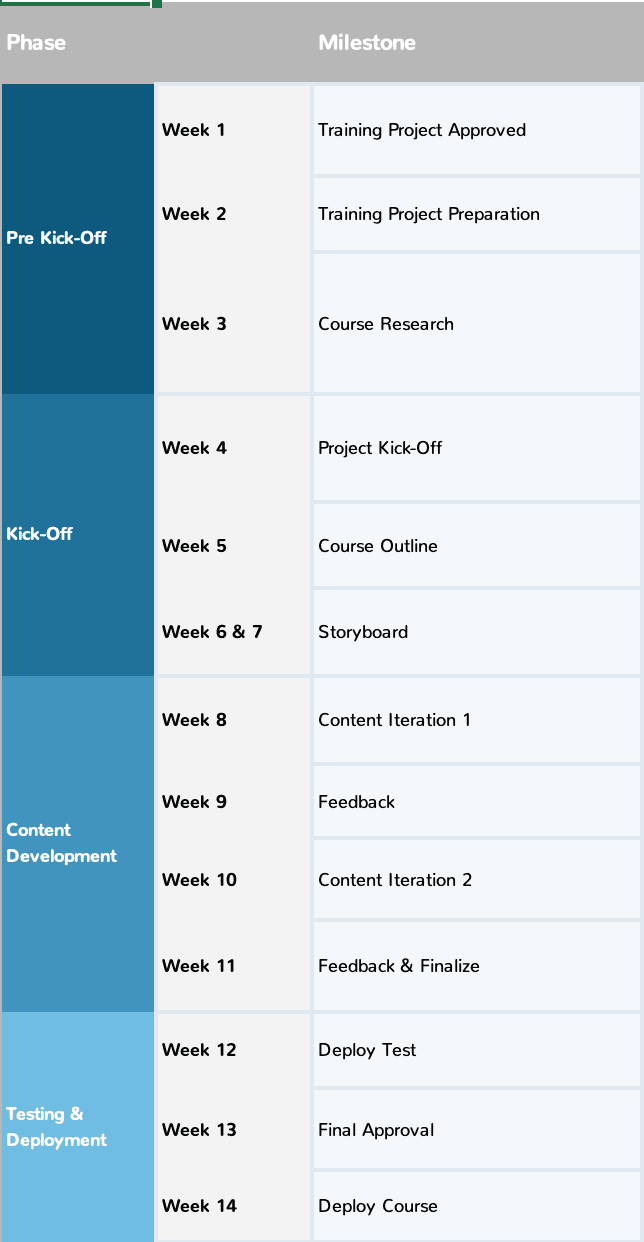As learning needs escalate for organizations of all sizes, finding the best way to rapidly build courses and get them to learners is a challenge.
Most course content is highly dependent on subject matter experts (SMEs). Their input is crucial, and even though a course might be built using well-designed templates that facilitate the generation of learning experiences, if the subject matter is not presented properly, the course will not resonate with learners and will fail to deliver the expected result.
We’ve written before about the need to include the SME in the planning, development and execution of a project from the get-go. Let’s have a closer look at how and where the SME should get most involved.

A rough outline of the timeline for a learning project.
1. Pre-Kickoff
This includes Training Project Approval and Preparation, in addition to Course Research.
However, you can work with your SMEs long before a course kicks off—perhaps even before the course is approved.
We’ve written before on the need for learning leaders to constantly be recruiting for SMEs throughout an organization. This is not from a standpoint of desperation but rather from the perspective of always having a stable of backup experts, discovering concepts for courses you didn’t think you needed, and of course, building an organizational culture of learning.
Some employees, when filling out a training request intake form, might even designate certain potential SMEs for a particular course. This accelerates the course research and development process.
2. Kick-Off
These steps include the Project Kick-Off, Course Outline and Storyboard.
This is perhaps the most crucial aspect of the process. The organization of content is critical to the construction of a course that makes sense for learners.
The good news is that most SMEs probably already have their expertise in some recorded format already. These might include:
- PowerPoint presentations, both to internal and external audiences
- Their own personal blog
- Videos taken from a conference they spoke at
- Podcasts or other recorded interviews
- A book or articles they may have written or collaborated on for the industry
- A course they may have already developed externally
In fact, an SME who does not already have existing, recorded expertise—even if it’s simply an article here or a video there—might be a red flag for the L&D team.
This is not to say that working with such SMEs would be difficult; it would simply mean that this stage of the learning project would require more attention, as a Course Outline and Storyboard are essential.
L&D professionals can provide input as to what works and what doesn’t, providing much-needed guidance on chapter length and course flow.

3. Content Development
These steps include several rounds of iteration and feedback on the proposed course content.
Once the outline of the course has been developed, this part should be quite easy for the SME. He or she would simply explain what he or she knows—explaining concepts and giving examples.
However, the role of experienced L&D professionals is still very much needed at this phase. While each course is different, learning professionals and instructional designers can weigh in and advise on language and style, based not only on corporate branding standards but also on past courses that proved successful.
You may need to provide a bit of training for the SME unaccustomed to receiving feedback on his or her content. You can explain that the typical audience for his or her work might be different from what he or she is used to in the past, and the focus is on improving learning outcomes.
There might also be a “backup” SME—selected by your main SME or perhaps someone you’ve identified internally or externally—who might be able to provide feedback on the content.
4. Testing and Deployment
This last phase incorporates deploying a test, receiving final approval, and launching the course.
Every organization has its own protocol for testing. You might wish to share with a small internal group of “testers,” perhaps even those who are not the target group for the training.
Hopefully, the course will sail through with flying colors, without the need to make too many adjustments. If the content at each step of the way was well planned and managed properly, then the testing phase should really only be a matter of the course working properly from a technical perspective—on the right devices and platforms, anytime, and anywhere.
Indeed, course content expires quickly—sometimes too quickly. When a course needs to be refactored, a proven process in place will make the refresh go much more smoothly.
And if the SME is truly passionate about his or her expertise and industry, he or she will happily and eagerly want to update the course with you and your team.

Take the stress out of working with cross-departmental training teams. Download the The Secret Formula for Working with SMEs – a toolkit with everything you need to make the process smoother.




